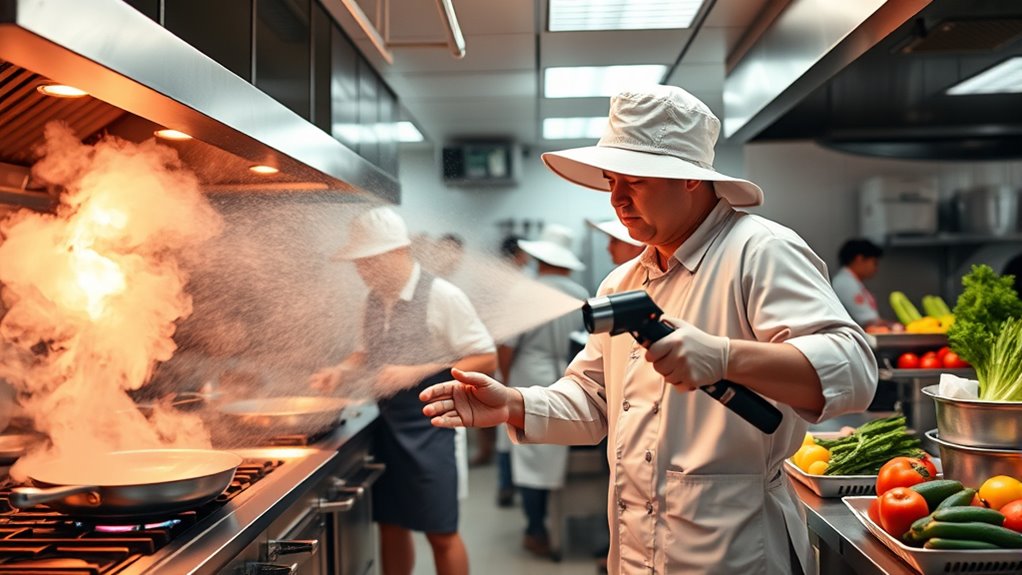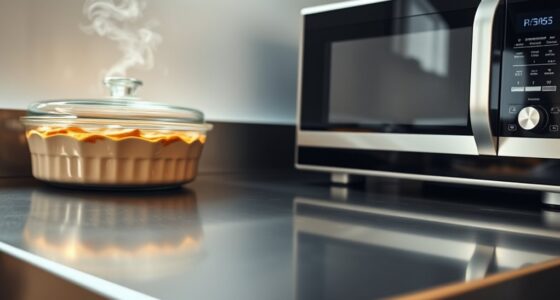To prevent heat stress, stay hydrated by drinking water regularly and avoid sugary or caffeinated drinks. Use fans, air conditioning, or cooling towels to lower your body temperature. Take short breaks in cooler areas and wear lightweight, breathable clothing. Pace your work, especially during hot hours, and watch for early signs of heat exhaustion like dizziness or headache. Prioritize your health and stay alert to safety tips—you’ll find more helpful strategies ahead.
Key Takeaways
- Ensure regular hydration with water and electrolyte drinks, even without thirst, to prevent dehydration.
- Use fans, air conditioning, and cooling devices like misting sprays to lower kitchen temperatures.
- Schedule work during cooler periods and take short breaks in cooler areas to reduce heat exposure.
- Wear lightweight, breathable clothing and apply cool cloths to help dissipate body heat.
- Train staff to recognize early signs of heat stress and respond promptly with rest and rehydration.

Working in a hot kitchen can quickly lead to heat stress, which poses serious health risks for staff. When temperatures soar, your body struggles to maintain its normal temperature, increasing the risk of heat exhaustion or even heat stroke. To stay safe, it’s essential to adopt effective hydration strategies and cooling techniques that help keep your body temperature in check. Proper hydration is the first line of defense. You should drink water regularly, even if you don’t feel thirsty, to prevent dehydration. Keep a water bottle nearby and take small, consistent sips throughout your shift. Avoid caffeinated or sugary drinks, as they can dehydrate you further. Incorporating electrolyte drinks can also be beneficial if you’re sweating heavily, as they help restore essential salts lost through perspiration.
Cooling techniques are equally important to combat the heat. Take advantage of any available fans or air conditioning units to create a cooler environment. If these aren’t available, consider using portable fans or misting devices to help lower your body temperature. When possible, take short breaks in cooler areas outside the kitchen or in designated break rooms. Use cool, damp cloths on your neck, wrists, or forehead to help disperse heat from your body. Wearing lightweight, loose-fitting, breathable clothing can also considerably aid in heat dissipation. Additionally, managing your movement and workload can prevent overheating; try to pace yourself, especially during peak hours when the kitchen is at its hottest. Staying aware of heat stress symptoms and acting promptly can make all the difference.
It’s essential to recognize early signs of heat stress, like dizziness, headache, excessive sweating, or weakness. If you notice these symptoms, immediately inform your supervisor and take a break in a cooler area. Resting and rehydrating are key to preventing escalation into more severe conditions. Remember, your health comes first—don’t ignore your body’s signals. Proper planning, such as scheduling work during cooler parts of the day when possible, can also reduce heat exposure. Employers should provide training on heat stress prevention and encourage staff to stay vigilant about hydration and cooling efforts.
Ultimately, staying hydrated and employing cooling techniques are your best defenses against heat stress in the kitchen. These simple yet effective practices help you maintain your health, stay alert, and perform your duties safely. By taking proactive steps, you can work effectively in hot environments while minimizing risks, ensuring everyone stays safe and healthy during busy shifts.
Frequently Asked Questions
How Can I Tell if I’M Experiencing Heat Stress?
You can tell you’re experiencing heat stress if you notice signs of dehydration like dry mouth, dizziness, or excessive sweating, along with symptoms of heatstroke such as confusion, rapid heartbeat, or nausea. If you feel extremely fatigued, have a headache, or your skin feels hot and dry, it’s vital to take action immediately. Recognizing these symptoms early helps prevent serious health issues, so stay aware and hydrate often.
Are There Specific Foods That Help Prevent Heat Stress?
Think of your body as a garden that needs watering to stay cool. Hydrating foods like watermelon, cucumbers, and oranges act as nature’s cooling snacks, helping to keep you refreshed. Incorporate these into your meals to boost hydration and prevent heat stress. Eating cooling snacks not only quenches your thirst but also supports your body’s effort to stay balanced in hot kitchen environments.
What Are Quick Relief Methods for Heat Exhaustion?
If you’re experiencing heat exhaustion, immediately stop working and move to a cooler place. Use cooling techniques like applying cool, damp cloths to your skin and fanning yourself. Hydration strategies are essential—drink water or electrolyte drinks slowly. Rest and avoid strenuous activity. These quick relief methods help lower your body temperature and replenish lost fluids, reducing the risk of more serious heat-related illnesses.
How Often Should Breaks Be Scheduled During Hot Shifts?
During hot shifts, you should schedule breaks every 1 to 2 hours to make certain of safety. Imagine a busy kitchen where staff take short, 10-minute breaks regularly; this helps maintain hydration and reduces heat stress. Incorporate hydration strategies like drinking water or electrolyte drinks during breaks. Proper break frequency keeps your team alert and prevents heat-related illnesses, ensuring everyone stays healthy and performs at their best throughout the shift.
Can Certain Clothing Improve Heat Stress Prevention?
Yes, wearing moisture-wicking fabrics and loose-fitting garments can improve heat stress prevention. Moisture-wicking fabrics help keep sweat away from your skin, reducing discomfort and cooling your body more effectively. Loose-fitting garments allow better airflow, which helps your body stay cooler during hot shifts. By choosing breathable, lightweight clothing, you can reduce heat buildup and stay safer and more comfortable while working in high temperatures.
Conclusion
By taking proactive steps, you can reduce heat stress risks in the kitchen. Remember, staying hydrated and taking regular breaks can cut heat-related illnesses by up to 50%. It’s vital to listen to your body and prioritize safety to keep yourself healthy and productive. Implementing simple measures not only protects you but also helps maintain a safe work environment for everyone. Stay cool, stay safe, and keep your team’s well-being top priority.








